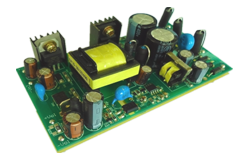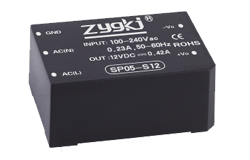nouvelles
DC Power Conversion: Understanding the Basics and Best Practices
Auteur: Module d'alimentation ZYG Time: 2023-6-4
Power conversion is an essential process in modern electronics, enabling devices to operate using different voltage and current levels. In this article, we will take a closer look at DC power conversion, its basics, and best practices.
DC power conversion refers to the process of converting DC voltage levels from one level to another. This process is necessary because different electronic devices operate using different voltage levels. For example, a smartphone may operate using a voltage of 3.7 volts, while a laptop may require a voltage of 19 volts. To ensure that electronic devices can operate efficiently and safely, DC power conversion is used to convert the voltage levels to suit the specific needs of each device.
The process of DC power conversion involves the use of power electronic devices such as diodes, transistors, and capacitors. These devices are used to regulate the voltage and current levels of the DC power, ensuring that the output voltage is the same as the input voltage, or that it is a specific value that is required by the device.
There are two main types of DC power conversion: linear and switching. Linear power conversion is a simple process that involves the use of a voltage regulator to maintain a constant voltage output. This process is highly efficient when the input voltage is close to the desired output voltage. However, when there is a significant difference between the input and output voltage, linear power conversion can result in high power losses, making it an inefficient method.
Switching power conversion, on the other hand, is a more complex process that involves the use of a switching regulator. This method is highly efficient, even when the input voltage is significantly different from the desired output voltage. The switching regulator works by switching the DC input voltage on and off at a high frequency, resulting in a stable output voltage. The switching regulator is highly efficient because it reduces the power loss associated with linear power conversion.
Best Practices for DC Power Conversion
When designing and implementing DC power conversion systems, there are several best practices that engineers should follow to ensure that the system is efficient, reliable, and safe. These best practices include:
1. Use High-Quality Components
The quality of the components used in the power conversion system can significantly impact the performance and reliability of the system. It is essential to use high-quality components that are designed to operate at the required voltage and current levels. Using low-quality components can result in system failure, safety hazards, and reduced efficiency.
2. Use Proper Cooling Techniques
Power conversion systems generate a significant amount of heat, which can impact the performance and reliability of the system. It is essential to use proper cooling techniques, such as heat sinks, fans, or liquid cooling, to ensure that the system operates at a safe temperature.

3. Follow Safety Standards
DC power conversion systems can pose a safety hazard if not designed and implemented correctly. It is essential to follow safety standards and guidelines, such as those set by the International Electrotechnical Commission (IEC), to ensure that the system is safe for use.
4. Test and Monitor the System
To ensure that the DC power conversion system is operating efficiently and reliably, it is essential to test and monitor the system regularly. This includes testing the system under different load conditions, monitoring the temperature of the components, and checking for any abnormal behavior.
Conclusion
DC power conversion is an essential process in modern electronics, enabling devices to operate using different voltage and current levels. Understanding the basics of DC power conversion and following best practices can help engineers design and implement efficient, reliable, and safe power conversion systems. By using high-quality components, proper cooling techniques, following safety standards, and testing and monitoring the system regularly, engineers can ensure that the DC power conversion system operates at peak performance.
Précédent: XXYY Series DC DC Converter
Prochain: Shop AC to DC Converters: Convert AC Power to DC with Ease!
les informations pertinentes
-
2023-5-25
Efficient 12V 15A AC to DC Converter for Reliable Power Conversion
Introduction Efficient power conversion is essential in modern electronics and electrical systems. When it comes to converting Alternating Current (AC) to Direct Current (DC), a reliable and efficient converter is needed. This article will discuss a 12V 15A AC to DC converter that is designed for efficient and reliable power conversion. What is an AC to DC Converter? An AC to DC converter is an electrical device that converts Alternating Current (AC) to Direct Current (DC). The conversion process involves rectifying the AC signal and filtering it to produce a smooth DC output. AC to DC converters are commonly used in electronic devices, such as power supplies, battery chargers, and motor drives. Features of the Efficient 12V 15A AC to...
Voir les détails -
2023-8-14
Introducing the DM Series: DC DC Power Supply for Enhanced Performance
In today's fast-paced and technologically advanced world, the need for reliable and efficient power supplies has become increasingly crucial. Industries such as telecommunications, automotive, and aerospace heavily rely on power supplies to ensure the smooth functioning of their electronic systems. To meet the growing demand for high-performance power supplies, we are proud to introduce the DM Series: a cutting-edge DC DC power supply designed to enhance performance and reliability. The DM Series is a result of years of research and development by our team of expert engineers. This power supply is specifically designed to provide a stable and efficient power source for a wide range of applications, including power amplifiers, data centers, and electric vehicles. With its advanced technology and...
Voir les détails -
2023-9-29
DC to DC Step-Down Adjustable Power Supply Module: Enhancing Voltage Regulation Efficiency
Introduction The demand for efficient and reliable power supply modules is increasing continuously. The DC to DC step-down adjustable power supply module is a vital component in various electronic devices, including smartphones, laptops, and IoT devices. This article explores the importance of voltage regulation efficiency in these power supply modules and how it can be enhanced to meet the growing demands of the industry. Importance of Voltage Regulation Efficiency Voltage regulation refers to the ability of a power supply module to maintain a constant output voltage regardless of input fluctuations or load variations. It is an essential characteristic as most electronic devices require a stable and precise voltage supply to function correctly. A slight deviation in the output voltage can...
Voir les détails -
2023-7-14
24V AC to DC Converter: Efficient Power Conversion for Electronic Devices
Introduction In today's world, electronic devices have become an integral part of our lives. From smartphones to laptops, we rely on these gadgets for communication, work, and entertainment. However, these devices require a stable and reliable power source to function properly. This is where a 24V AC to DC converter comes into play. In this article, we will explore the benefits and importance of efficient power conversion for electronic devices. What is a 24V AC to DC Converter? A 24V AC to DC converter is an electrical device that converts alternating current (AC) to direct current (DC) with a voltage output of 24 volts. This conversion is necessary because most electronic devices operate on DC power. The converter ensures that...
Voir les détails -
2023-6-7
China High-Voltage Power Series
High-voltage power series are a vital part of modern electric power systems and are used extensively in various industrial and commercial applications. These devices are designed to provide a stable and reliable flow of electricity at high voltages, and they are used to power heavy machinery and other electrical equipment. The high-voltage power series consists of several different components, all of which are designed to work together to provide a stable and efficient power supply. These components include transformers, circuit breakers, disconnect switches, and surge arresters. Transformers are used to increase or decrease the voltage of an electrical signal. They are critical components in power distribution systems and are used to step up the voltage of the power supply to...
Voir les détails -
2023-8-24
Efficient AC to DC Converter for LED Lights: A 12V Solution
Introduction LED lights are becoming increasingly popular due to their energy efficiency and long lifespan. However, to power these lights, an efficient AC to DC converter is required. In this article, we will explore a 12V solution for converting AC power to DC power for LED lights. This solution offers high efficiency and reliability, making it an ideal choice for various lighting applications. Background LED lights operate on direct current (DC) power, whereas the power supplied from the electrical grid is in the form of alternating current (AC). Therefore, a converter is necessary to transform the AC power into the required DC power for LED lights to function properly. The efficiency of this conversion process is crucial to minimize energy...
Voir les détails


















